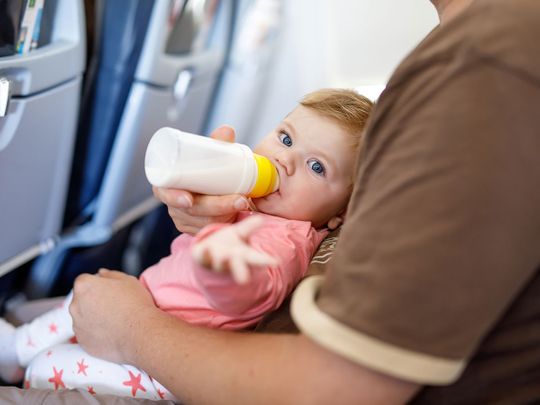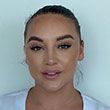
Are flights breastfeeding friendly? Should you bottle and carry milk on-board? Are you even allowed to breastfeed while flying?
If these questions are dampening your excitement for upcoming travel, know that you are not alone. Hannah Duncan, Lead Midwife and Nurse Manager at Nightingale Dubai, says: “As a midwife and lactation advisor, I get asked this question a lot from new mums.” However, there are plenty of tips that can make the ride smoother.
This is what you need to know:
Things to pack
Duncan lists these essentials:
- Burp cloth
- Cover up
- Breastfeeding pillow
- Change of top
- Comfortable and supportive nursing bra
- Ziploc bag filled with frozen grapes if you plan to pump and store breastmilk as ice melts
- Sterile bottles (in case you need to express or the baby doesn’t latch on the flight)
Carrying expressed milk on a flight
There are a few different ways to fly with breast milk, says Duncan. “In most cases, it will make the most sense to carry the milk in a small travel cooler.
“It must be in liquid form, not frozen, and must be presented in individual containers no larger than two litres. The milk will be subjected to screening before being allowed on an aircraft. Passengers will not have to be accompanied by the breastfeeding infant,” she says.

Expressed milk must be in liquid form, not frozen, and must be presented in individual containers no larger than two litres.
Top tip: “If you have a long flight, the flight attendant may be able to provide you with ice to put in your breast milk cooler bag to keep the milk cool, but usually won’t be able to store it for you. Check individual airlines breastfeeding policies before you fly as the rules differ,” Duncan says.
Time the feed
“Always offer to feed your baby before take-off and landing as this helps with the pressure within the ear from transitioning between different altitudes; breastfeeding will help with distract babies resulting in fewer tears,” adds Duncan.
Wondering where to sit?
Choose an aisle seat, suggests Duncan. “Aisle seats allow you to have more range of movement for positioning your baby when feeding and more space to get up and down if needed,” she explains.
Feeling shy or awkward?
Speak to the flight attendant, says Duncan. “As a first-time mum, I know feeding in a small space in front of a lot of people can be very nerve racking.
“If you are feeling like this, then please speak to the flight crew to discuss your nursing concerns. Politely ask if you can get your initial positioning and attachment started off within the galley of the airplane while they are out serving so you have some private time, then you can go back to your seat to continue nursing in a more comfortable position,” she says.

Using a sling or stretchy wrap can make breastfeeding in an airport easier as well as keep baby calm. It can also allow you to be hands free.
Cecile de Scally, midwife educator at Dubai-based Malaak, Mama and Baby Care, has the following 7 tips for mums:
- Make sure you stay well hydrated.
- Take additional snacks for yourself as you need to keep up your calories.
- Feed your baby a little more often as they may need it.
- Ensure you have a cover to avoid your baby being distracted or other people giving you unneeded attention.
- Ask the staff if you could feed somewhere private.
- Using a sling or stretchy wrap can make breastfeeding in an airport easier as well as keep baby calm. It can also allow you to be hands free.
- If you do not wish to feed on the way, pump in advance; having a double pump that is battery operated is best. Remember, however, to take spare batteries.
Have a topic you'd like us to discuss? Write in to us at parenting@gulfnews.com








